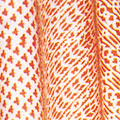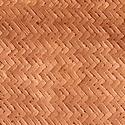
Hand-Block Printing, Saris/Unstitched Garments, Textiles, Weaving, Spinning, Khadi
Hand Block – Printing on Textiles of Nepal
The tradition of using wooden blocks to hand print saris and other textiles in Nepal is an ancient one; however, with the increasingly large scale import of silk and synthetic saris it is in serious danger of dying out. Hand-block printing by the ranjitkar, the specific Newar hereditary caste of block printers and dyers, has a long tradition in the Kathmandu Valley. Hand-blocked saris, once greatly in demand, are rarely worn now; however, hand-printed shawls, blouses, jackets, and waistbands are still popular. Unfortunately, the white cotton cloth with the distinctive black and red block-print patterns has now to compete with cheaper, imported copies.
PROCESS & TECHNIQUE
The very basis of the ranjitkars’ craft are the carved wooden blocks used during the process of printing. Each printer has a wide variety of carved blocks of varied patterns. These blocks are made of seasoned dar wood – this wood does not warp or bend even when moist. Soft wood is also used in Nepal to make wood blocks. The dimensions of the wooden block, on an average, are 18 x 13 cm; the blocks are fitted with a handle.
The cloth used for printing are of the following varieties: nainsut, markin, malmal, khaddar, and dambarkumari (a variety of cloth that is mostly used by women). Blouses, saris, belt cloths (patuka), etc. are made out of dambarkumari cloth which is somewhat finer than khaddar. The gunyu and cholo traditionally given to young girls are usually made of gawun cloth – this is full of designs, with a red, blue, or black background. Gawun cloth is a favourite with women in the hilly areas. They wear khaddar or dambarkumari saris in their daily life, while the gawun sari is carefully preserved for festive occasions.

The first step is to remove the starch used during the process of sizing the cloth. This starchy matter needs to be thoroughly removed with a good wash so that the cloth is ready to accept the colour dyes. The cloth is then folded and placed on a wooden anvil (dashi) and pounded with a wooden hammer. The hammer – made of a heavy wood called chilaune– is about 12 inches in length and is 5″-6″ in circumference. After pounding, the cloth is completely smoothened and ready for printing.
Three to four layers of jute are evenly placed on the printing table, and covered with a woollen spread. This padding allows for an even spread of colour and print on the fabric. The block receives the dye from the dye (pa) box. This box, made of wood, in a size of about 10″ x 8″ x 1.5″, is layered with jute and is covered with a fine soft cotton sheet, colloquially called astar. The purpose of this astar is to make the wooden block receive only the correct amount of dye. After the ranjitkar has poured the required amount of dye into the pa box he is ready to start printing. Traditional ranjitkars who, for centuries, used natural dyes that they made themselves, have now begun to use imported dyes and colours.
The fabric for printing is spread tight on the jute and woollen layers on the wooden table. The ranjitkar gently presses the wooden block on the pa box, and then applies – with even weight – the block on to the cloth. In this manner, the design is and printed on the plain cloth. An experienced printer can print about 15-20 saris, each 8 m, in one day.
The dot and line patterned design is made by the Newarchippahs settled in east Nepal. To print five 40 x 80 cm cotton lengths, the chippah firstly prepares a black dye from 200 g of mustard seed powder, 200 g of millet flour, and 1,000 g of iron dust. These are put into a clay jar, covered with water and stirred once a week for two to three 2 to 3 weeks. A second liquid is prepared by immersing the leaves of asuro (Adhatoda vasica) in water in a clay jar for a week to become a yellow juice. The cotton cloth is soaked in water, rubbed with crushed myrobalan paste, then dried, folded, and beaten. The wood block with the carved out dot/line pattern is printed with the first mixture, giving the black background. The second block, with stripes wide enough to cover the dot pattern, is printed over the dot pattern with a mixture prepared from one of the yellowish asuro liquid into which 20 gm of mineral salt (khar) is mixed. When it starts to effervesce, two to three drops of mustard oil are added. The printed cloth is dried in the sun before it is submerged in a madder dye (powdered madder plus water) and simmered for 5-10 minutes, resulting in black/brown background, red/brown background, red/brown lines, and white dots (which have been prevented from accepting colour by the asuro liquid). Today the cloth is worn mostly by the older generation of Limbu and Rai.

SYMBOLS & MOTIFS
The motifs and patterns used draw inspiration from well-known and symbolic objects. Printing patterns are numerous and are generally referred to as butta, a floral motif – these include fish motifs, stars, flowers, lines, and dots and a rich combination of small geometric patterns, often arranged diagonally. Each characteristic and easily recoginisable pattern and print has its own lyrical name individually assigned to it, like chilpa, butwali, mujia, dhakka, and dambarkumari. The prints, patterns, and colours used are specific and characteristic of the community that does them, thereby making the wearer instantly recoginisable. In the same way that the black sari of Lalitpur identifies the Jyapuni women agriculturalists, so the chippa sari instantly identifies the women of the hill regions. Traditionally Nepalese parents offer saris and blouses called gunyu and cholo to their daughters between the age of 7 and 11, or before they reach puberty.
DEVELOPMENTS
A relatively new development is the use of locally produced lokta bark paper, printed with the block prints of Nepali, Tibetan, and Chinese deities. They are sold as pictures or are sold as calendars, cards, and lanterns.
Gallery
YOUR VIEWS
PRACTITIONERS: INDIA
Access 70,000+ practitioners in 2500+ crafts across India.
BIBLIOGRAPHY
10,000+ listings on arts, crafts, design, heritage, culture etc.
GLOSSARY
Rich and often unfamiliar vocabulary of crafts and textiles.
SHOP at India InCH
Needs to be written.





